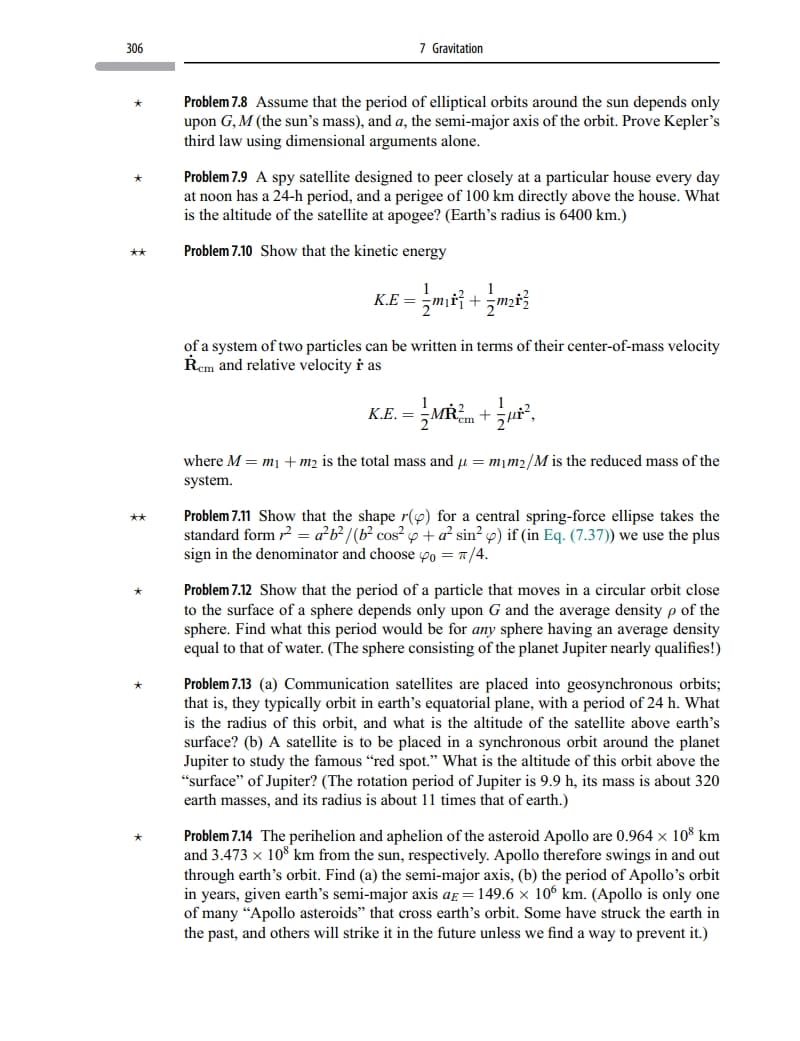Problem 7.10 Show that the kinetic energy K.E = {m₁²+ m₂ of a system of two particles can be written in terms of their center-of-mass velocity Rem and relative velocity i as 1 K.E. „E. = — MŘ²m + µ²², where M = my + m2 is the total mass and μ = mm₂/M is the reduced mass of the system.
Problem 7.10 Show that the kinetic energy K.E = {m₁²+ m₂ of a system of two particles can be written in terms of their center-of-mass velocity Rem and relative velocity i as 1 K.E. „E. = — MŘ²m + µ²², where M = my + m2 is the total mass and μ = mm₂/M is the reduced mass of the system.
Physics for Scientists and Engineers: Foundations and Connections
1st Edition
ISBN:9781133939146
Author:Katz, Debora M.
Publisher:Katz, Debora M.
Chapter8: Conservation Of Energy
Section: Chapter Questions
Problem 64PQ: FIGURE 8.38 Comparison of a circular and an elliptical orbit. The semimajor axis of the ellipse is...
Related questions
Question
100%
Problem 7.10 Please.

Transcribed Image Text:306
**
**
Problem 7.8 Assume that the period of elliptical orbits around the sun depends only
upon G, M (the sun's mass), and a, the semi-major axis of the orbit. Prove Kepler's
third law using dimensional arguments alone.
Problem 7.9 A spy satellite designed to peer closely at a particular house every day
at noon has a 24-h period, and a perigee of 100 km directly above the house. What
is the altitude of the satellite at apogee? (Earth's radius is 6400 km.)
Problem 7.10 Show that the kinetic energy
7 Gravitation
where M = mi
system.
K.E=
| = {m} + {/m₂²²
of a system of two particles can be written in terms of their center-of-mass velocity
Rem and relative velocity i as
1
= {MŘ²m + ½µř³²³,
K.E. =
m2 is the total mass and
m1m2/M is the reduced mass of the
Problem 7.11 Show that the shape r() for a central spring-force ellipse takes the
standard form ² = a²b²/(b² cos² y + a² sin² p) if (in Eq. (7.37)) we use the plus
sign in the denominator and choose 40 = π/4.
Problem 7.12 Show that the period of a particle that moves in a circular orbit close
to the surface of a sphere depends only upon G and the average density p of the
sphere. Find what this period would be for any sphere having an average density
equal to that of water. (The sphere consisting of the planet Jupiter nearly qualifies!)
Problem 7.13 (a) Communication satellites are placed into geosynchronous orbits;
that is, they typically orbit in earth's equatorial plane, with a period of 24 h. What
is the radius of this orbit, and what is the altitude of the satellite above earth's
surface? (b) A satellite is to be placed in a synchronous orbit around the planet
Jupiter to study the famous "red spot." What is the altitude of this orbit above the
"surface" of Jupiter? (The rotation period of Jupiter is 9.9 h, its mass is about 320
earth masses, and its radius is about 11 times that of earth.)
Problem 7.14 The perihelion and aphelion of the asteroid Apollo are 0.964 x 108 km
and 3.473 x 108 km from the sun, respectively. Apollo therefore swings in and out
through earth's orbit. Find (a) the semi-major axis, (b) the period of Apollo's orbit
in years, given earth's semi-major axis aɛ= 149.6 x 106 km. (Apollo is only one
of many "Apollo asteroids" that cross earth's orbit. Some have struck the earth in
the past, and others will strike it in the future unless we find a way to prevent it.)
Expert Solution
This question has been solved!
Explore an expertly crafted, step-by-step solution for a thorough understanding of key concepts.
Step by step
Solved in 4 steps with 4 images

Knowledge Booster
Learn more about
Need a deep-dive on the concept behind this application? Look no further. Learn more about this topic, physics and related others by exploring similar questions and additional content below.Recommended textbooks for you

Physics for Scientists and Engineers: Foundations…
Physics
ISBN:
9781133939146
Author:
Katz, Debora M.
Publisher:
Cengage Learning


Physics for Scientists and Engineers
Physics
ISBN:
9781337553278
Author:
Raymond A. Serway, John W. Jewett
Publisher:
Cengage Learning

Physics for Scientists and Engineers: Foundations…
Physics
ISBN:
9781133939146
Author:
Katz, Debora M.
Publisher:
Cengage Learning


Physics for Scientists and Engineers
Physics
ISBN:
9781337553278
Author:
Raymond A. Serway, John W. Jewett
Publisher:
Cengage Learning

Physics for Scientists and Engineers with Modern …
Physics
ISBN:
9781337553292
Author:
Raymond A. Serway, John W. Jewett
Publisher:
Cengage Learning

Principles of Physics: A Calculus-Based Text
Physics
ISBN:
9781133104261
Author:
Raymond A. Serway, John W. Jewett
Publisher:
Cengage Learning

College Physics
Physics
ISBN:
9781305952300
Author:
Raymond A. Serway, Chris Vuille
Publisher:
Cengage Learning